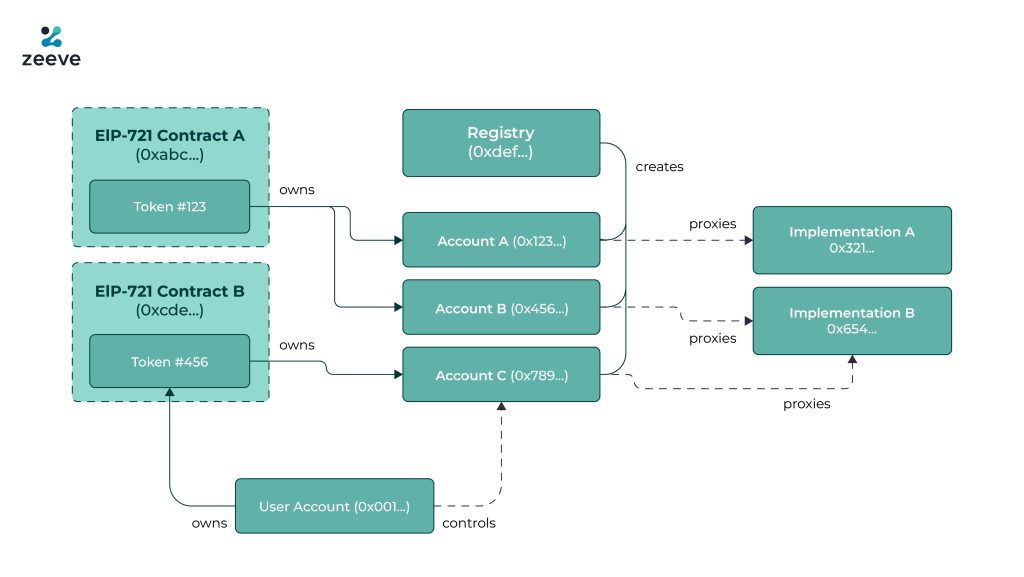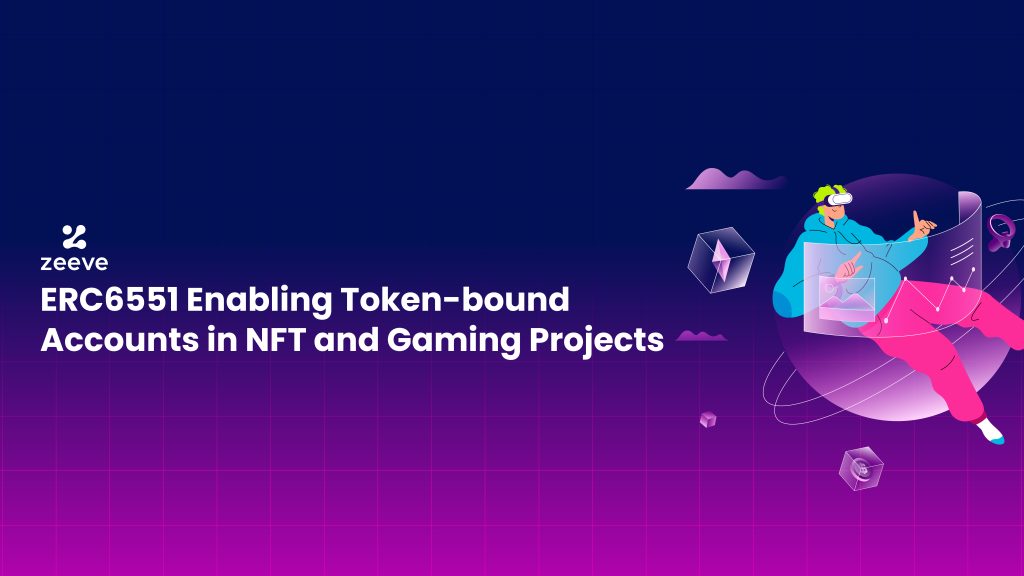NFTs, or non-fungible tokens, have already taken the gaming and NFT world by storm since its inception in 2018 with the ERC-721 token standard. Talking about the present scenario, ERC-6551 has piqued the interest of many, including gaming companies, NFT creators, investors, and developers.
ERC-6551 is a revolutionary feature that has been introduced to the NFT world with ‘Token Bound Accounts’ for powering dynamic NFTs. Its concept of associating individual wallets or the ‘Backpack’ wallet with each NFT is highly useful for futuristic gaming and NFT projects where NFTs are traded back and forth in high volume. Token-bound accounts also address the issue of wallet custody, complex key strings, and user experiences in NFTs, which are the toughest barriers for new web3 enthusiasts.
There’s a lot more to know about ERC-6551 in gaming and NFT that we will discuss in this article, covering the definition, importance, architecture, utility, and possible use cases.
Understanding the broader concept of ERC-6551
ERC-6551 is an EIP— Ethereum Improvement Proposal created with the joint effort of developers and NFT experts from Future Primitive- the Web3 venture studio, and the NFT creator platform– Manifold.
ERC-6551 in gaming and NFT-based projects aims to solve several challenges associated with NFTs, including the hard problem of making the NFTs dynamic. Being dynamic, non-fungible tokens can own other NFTs, change their aesthetics, and perform on-chain actions through independent wallets. Before introducing ERC-6551, Ethereum analyzed that there are following two ways to add state to the NFTs:
- Pursuing the off-chain way requires building and managing huge databases, relying on centralized servers to render the desired non-fungible tokens.
- Or, the on-chain way, where every NFT item can be seamlessly equipped on-chain as transactions so that aesthetics can be changed without hassle.
Knowing that the on-chain way is relevant and feasible, the Ethereum community did further research and experiments to come up with a potential solution— ERC-6551. This standard links NFTs with their ‘token-bound account’ or ‘token-bound wallets’ so they can own a range of ERC tokens such as ERC-721, ERC-1155, USDC, or ETH.
NFTs that are launched ever since ERC-721 came into existence and those are going to launch can have their own wallet and a unique smart contract wallet address that enables them to own assets and take action on-chain, claim ownership, carry unique identity signature and message other wallet address transactions similar to how things work in regular web3 wallets.
By providing a separate wallet to every NFT on Ethereum and on any EVM-compatible chain, ERC-6551 unlocks enormous possibilities for NFT projects that are based on PFP (profile picture). Gaming or NFT projects that offer avatars, have benefited considerably with the launch of ERC-6551 as they can now allow NFT characters to own desired NFTs and thereby change their aesthetics, like putting on new hats, shoes, clothes, and accessories.
The need for ERC-6551 in Gaming and NFT projects
ERC-6551 is a crucial feature for all types of web3 projects, more importantly for Gaming and NFT projects, as it allows users (or their NFT character) to own digital assets, a range of crypto tokens, and NFTs themselves through token-bound wallets.
However, ERC-6551 is the first attempt to provide NFTs the ability to own digital assets and blockchain-based tokens. A good example is ERC-998, where users can own only ERC-20 and ERC-721 but not ERC-1155 because ERC-1155 was launched after ERC-998. This shortcoming is because NFT smart contracts require custom logic, which the NFT creator or NFT developer must create when launching NFTs. These smart contract logics, once created, cannot be altered or optimized; hence further support for new tokens cannot be enabled.
In the context of ERC-6551 in Gaming and NFTs, wallets are implemented along with smart contract, and as we know, wallets are not bound by any logic-based limitations, and they can own any asset or perform desired actions as per project-specific requirements.
Also Read: Introduction to Token Standards: ERC-20, ERC-721, ERC-777, and ERC-1155
The technical architecture of ERC-6551
The technical architecture of ERC-6551 is based on token-bound accounts that allow ERC-721 tokens to own a variety of NFT-powered digital assets via independent wallets and to be able to interact with various decentralized applications without the need to modify the smart contract logics or the token infrastructure. To understand how token-bound accounts enable ERC-721 (NFTs) to utilize ERC-6551, let’s examine the architectural image given below:

As we can see, the ERC-6551’s architecture has three components– the ERC-721 contracts, the registry, and standard implementation interfaces. ERC-721 contracts are the smart contracts for NFTs, while the Registry is the entry point for NFT projects that want to deploy token-bound accounts. Lastly, the standard interface implements token-bound accounts in the required ERC-721 contracts.
Advantages and use cases of ERC-6551 in Gaming and NFT projects
Following are the main benefits of ERC-6551 in Gaming and NFT projects. Note that these benefits are also linked to other categories of NFT projects, such as real estate, fashion brands, and sports.
More enhanced gaming and user experience
Gaming and NFT projects are the forerunners in terms of adopting ERC-6551. Gaming enthusiasts can integrate token-bound wallets into NFTs and create “Network Playable Characters” for gamification. These characters are interesting because they can travel across multiple gaming ecosystems, own NFT-based assets, customize their appearance, and perform precise actions based on the smart contract logic programmed for them. With this ability to create NPCs, web3 game developers can enhance the player experience, monetize the in-game assets properly, and unlock a plethora of opportunities for NFT creators to collect rewards and monetize their merchandise.
Fully on-chain identity management
ERC-6551 fully manages the NFT identity on-chain by establishing a connection between the user’s identity and their digital assets. Each NFT is associated with a token-bound account, including a smart contract wallet– individuals get full control and immutable ownership of their NFTs and other tokens. Such a unique identity management system is useful for NFT and gaming projects as they require high transparency and authenticity across their project’s digital environment.
Enhanced tradability for better revenue
ERC-6551 in gaming and NFT projects allows for creation of a tradable wallet that you can into the existing ecosystem. This enables the ownership in token-bound accounts to be transferred with the transfer of NFT itself; thereby, the tradability enhances across these projects, which results in better user engagement and higher revenue eventually.
Cross-platform interoperability for NFT projects
ERC-6551 in gaming and NFTssolves the biggest challenge of interoperability besides enabling seamless cross-platform NFT integration. NFTs, with their wallets, can communicate with any dApps and digital ecosystem for a seamless flow of assets. This interoperability element allows gaming and NFT projects to support the exchange of assets between different projects, thereby enabling the users/players to unlock new possibilities of investment and interaction.
Unbounded security through multiple layers
As ERC-6551 provides individual wallets for every NFT, it distributes the security and trust on multiple layers. Instead of storing the tokens, credentials, badges, and all these things on a web3 wallet (for example, Metamask), ERC-6551 in gaming and NFT projects allows the users to manage numerous NFT wallets through token-bound accounts and manage all these wallets inside the main wallet. Further, ERC-6551 supports hardware and software wallets-based approaches that you can adopt to maintain robust security of wallets and associated private keys.
Hierarchical ownership management
ERC-6551 allows gaming and NFT projects to maintain on-chain ownership records by transforming individual NFTs into multiple, unique token-bound accounts integrated with custom smart contracts and wallets. Further, ERC-6551-based projects can use the underlying blockchain technology to prevent tampering with any ownership-related data. Note that all your token-bound accounts are managed inside the Metamask, which means the main wallet, by default, has control over all the NFT wallets stored inside it. This concept of hierarchical ownership prevents fraud and manipulation related to NFT ownership that is likely to happen on gaming and NFT projects.
Popular companies using ERC-6551
Opensea- the globally popular NFT marketplace, has been using an ERC-6551-based display to investigate the assets associated with various NFTs. Also, it supports various customization options for the characters using the stateful NFTs from ERC-6551. Lens– the popular decentralized social media platform recently rolled out its latest update, enabling ERC-6551 tokens to custody their corresponding social media profiles on the platform. Earlier, the famous fashion designer Jeff Staple announced the implementation of ERC-6551 into their existing SAPIENZ NFT collection of playable characters, enabling the token holders to use token-bound accounts to own the external NFTs.
The future of ERC-6551
ERC-6551 is yet to be announced as an official Ethereum token standard, though it is already utilized across hundreds of gaming and NFT projects with a greater degree of functionality, interoperability, and NFT tradability. DAOs, real-estate, and Edtech are the other major areas where projects are utilizing the ability of ERC-6551 to provide wallets to NFTs and add state to them. As we dive deeper into future possibilities, we see the amalgamation of artificial intelligence with ERC-6551 in gaming and NFT projects, boosting the population of NPCs or network playable characters on the Metaverse, blockchain gaming platform, and NFT worlds. Also, NFT wallets will certainly stimulate AI models to program their custom NFT or NPCs to perform the on-chain actions you want.
If you are planning to build Ethereum-based or any web3 solutions, such as a crypto gaming platform, NFT marketplaces wallet-as-a-service platform, crypto exchanges, lending solutions, or any complex project, connect with Zeeve to simplify your journey. We provide reliable infrastructure to deploy nodes/ endpoints and meanwhile, provide monitoring of all your web3 platforms along with their components like wallets, explorers, tokens, etc. We enable a token standard of your choice, ranging from ERC-20 to ERC-721, ERC-1155, and ERC-6551. Schedule a call with our blockchain consultant today for more information on Zeeve’s service or to discuss your project requirements.
Frequently Asked Questions about ERC-6551
What is ERC-6551?
ERC-6551 is an Ethereum-based feature or Ethereum improvement plan to associate token-bound accounts/wallets with each NFT powered by the ERC-721 token standard.
What is a token-bound account?
A token-bound account is simply a type of wallet you can manage using any web3 wallet like Metamask. TBA provides NFTs with unique wallet addresses, and these wallet addresses can own any assets they wish.
Can I customize the smart contracts for each NFT I own?
Yes, ERC-6551 allows you to implement custom smart contracts for each NFT. For example, you can program the contract for gaming and NFT projects to enable mintable, burnable, or sellable features as required.
Do I need a special wallet to initiate ERC-6551 transactions?
No, you can manage all your NFT wallets and their associated transactions inside any popular web3 wallet like Metamask or Coinbase wallet. It’s basically like managing wallets inside a wallet.
Will token-bound wallet transactions cost me higher gas fees?
Based on the visualization done by NFT experts, ERC-6551 wallets or token-bound wallet accounts will cost fairly low gas fees even when the network fee is higher than average.























